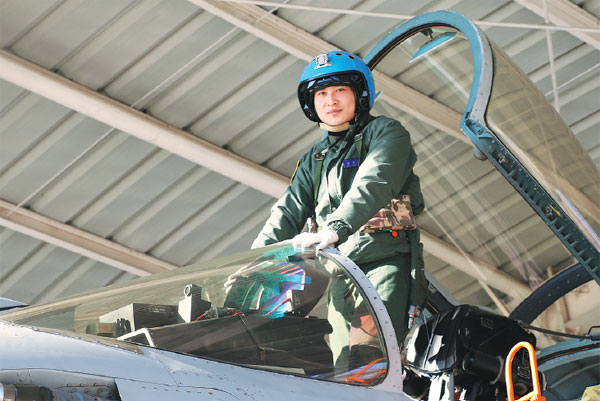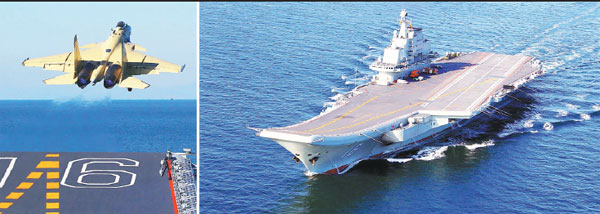
Pilot Zhang Chao poses for a photo before flying a J-15 "Flying Shark" fighter jet. The 29-year-old lieutenant commander died in April during a routine training exercise. (Photo provided to China Daily)
The People's Liberation Army, which celebrated the 89th anniversary of its foundation on Monday, is building up a naval-aviation division to safeguard China's maritime interests. Zhao Lei reports.
For most Chinese people, the People's Liberation Army Navy's aircraft carrier and carrier-based aviation force are some of the most mysterious military units, and also the ones they most want to know about.
Only a very small number of people outside the PLA, which was founded on Aug 1, 1927, have been invited to visit the CNS Liaoning, China's first aircraft carrier. Everyone else merely sees the colossal vessel and its planes once or twice a year on the TV news.
The only time the carrier-based aircraft have been displayed publically was during a parade on Sept 3 last year to mark the 70th anniversary of the end of World War II and China's victory in the War of Resistance against Japanese Aggression (1937-45).
That morning, five J-15 "Flying Shark" carrier-borne fighter jets, led by Senior Captain Dai Mingmeng, commander of the PLA Navy's carrier-based aviation force, flew over Tian'anmen Square in Beijing, exciting the crowds as an announcer introduced them as the nation's first fixed-wing carrier-based jets.
China commissioned the CNS Liaoning in September 2012. Two months later, Dai landed a J-15 on the carrier's flight deck, becoming the first Chinese pilot to do so. In May 2013, the carrier-borne aircraft unit, the first of its kind in the PLA Navy, was established.
Although it's only about three years since the unit came into being, the carrier-borne force has already trained several groups of J-15 pilots, Dai said at a media briefing at a naval-aviation base.
"It will not take long for us to attain full operational capability on the aircraft carrier," he said. "My pilots train very hard. Their biggest wish is to become good carrier-based fliers as quickly as possible and then safeguard our motherland's interests from above the oceans."
The unit has made tremendous progress and improvements in training, and is moving closer to forming a combat-ready force, the PLA Navy said.
Tragedy
The military has rarely publicized pilot's stories, so few people know the hardships and struggles they experience and the sacrifices they make. That changed when the PLA Navy decided to tell the story of Zhang Chao, a J-15 pilot who died in April during a routine training exercise.
The 29-year-old lieutenant commander was the first member of the unit to die in the line of duty.
On the afternoon of April 27, Zhang was preparing to land after a routine training session, when the computer on his J-15 suddenly reported a malfunction in the flight-control system. Within seconds, the aircraft had pitched by 80 degrees and began soaring skyward. An investigation concluded that Zhang had tried unsuccessfully to save the plane, and he had no option but to eject from the cockpit before the fighter aircraft crashed.
Because the plane was at a relatively low altitude, there wasn't time for his parachute to be fully deployed before Zhang hit the ground. He was rushed to a nearby hospital but died as a result of serious internal injuries.
Zhang was recruited by the PLA Navy in 2004 after graduating from a middle school in Yueyang, Hunan province. He trained as a fighter jet pilot for five years and in 2009 he joined a naval aviation squadron.
Inspired by the media coverage of Dai's maneuvers on the CNS Liaoning, the young pilot decided to employ every means possible to join the carrier-based unit.
"When I met Zhang during the selection procedures, I told him that being a fighter jet pilot on the carrier meant accepting all possible risks. However, he replied that his dream was to fly the best aircraft on the carrier and that someone had to do the risky job," Dai recalled.
In March last year, Zhang passed the stringent selection procedures and became a pilot in the carrier-based aviation force.
Senior Captain Zhang Ye, the unit's chief of staff, said Zhang Chao always trained hard and made rapid progress after he joined the J-15 team.
"The young man set a high goal and strict standards for himself in training because he wanted to become a good J-15 pilot as quickly as possible," he said, adding that Zhang Chao also had volunteered to help compile a guidebook on the use of airborne weapons.
Other pilots who trained with Zhang Chao at the unit have decided to perform a ceremony to remember their fallen comrade when they land on the CNS Liaoning for the first time, according to Captain Sun Baosong, deputy commander of the unit's J-15 squadron, who worked with Zhang Chao.
"Flying a J-15 above the carrier was Zhang Chao's biggest wish. We will fulfill that wish for him," Sun said.



















































